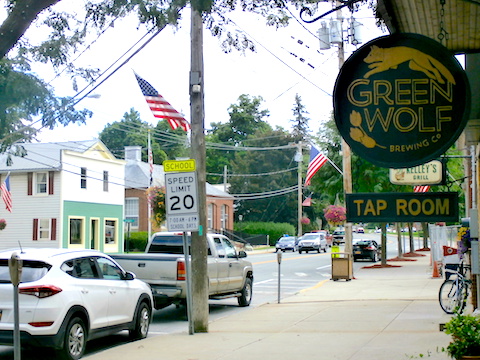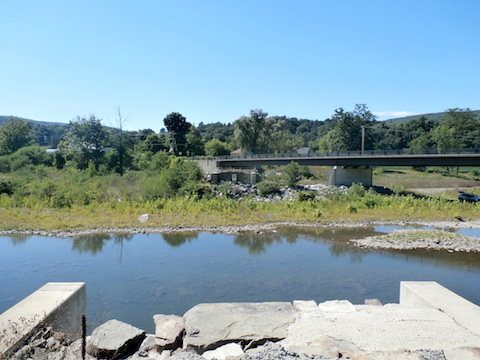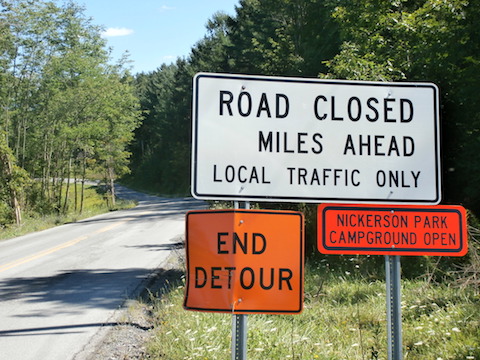Above: A widely-circulated photo of the flooded Schoharie Valley during Tropical Storm Irene in 2011, as seen from the top of the cliffs of Vroman’s Nose. Photo by Amy Colyer Fogerty.
The air was perfectly calm in the late hours of Saturday, August 27, 2011. A hurricane was heading north up the East Coast, with forecasters saying that there was a chance that the storm would push inland in New York and impact the Catskills region.
It had been raining heavily for weeks, and the creeks were swollen. So, too, was the Gilboa Dam, which holds back 19.6 billion gallons of drinking water bound for New York City in a reservoir on the Schoharie Creek. Within 24 hours of that calm Saturday evening, all of the Schoharie Valley was forever changed.
This article is part of our series of stories commemorating the five-year anniversary of Tropical Storm Irene in the Catskills.
When the floodwaters caused by Tropical Storm Irene came rushing down the Schoharie Creek five years ago on Sunday, August 28, 2011, the communities that line the Schoharie Creek in the Schoharie Valley were inundated.
Thousands of acres of farmland, hundreds of homes and dozens of businesses were destroyed in a single day. The rising waters of the creek washed the historic Blenheim Covered Bridge off of its abutments and completely obliterated the first floor of the county jail.
Everything located on the valley’s fertile floor was caught in the devastation, as the floodwaters turned the banks of the creek into a miles-long path of debris and destruction.
The flood forced the Schoharie Valley into a state of prolonged recovery, which has taken many different forms over the past five years.
Today, signs of damage caused by the flood are still visible across the county. But there are also many signs of resilience.
For some communities, recovery has meant paving roads and fixing houses. In others, recovery has meant revitalizing downtown districts and inviting new businesses to move in.
Progress is evident at every turn you take in the Schoharie Valley, but so is the unfinished business of recovery.
Reminders of disaster; signs of recovery
The village of Middleburgh, which saw its Main Street covered in water and mud during the flood, now stands as the crown jewel of the Schoharie Valley’s recovery.
Business that survived the flooding on Main Street Middleburgh, such as the Conglomerate and Hubie's Pizzeria, have reopened, while new shops, such as the Green Wolf Brewing Company brewpub and the Green Iguana restaurant, have appeared, along with new murals and floral plantings, the results of a recent beautification effort.

Above: Since the flood, the village of Middleburgh has enjoyed a renaissance, with new businesses, like the Green Wolf Brewing Company, opening on Main Street. Photo by Timothy Knight.
Down the road, the village of Schoharie, where dozens of homes were permanently destroyed by the flood, is regaining its footing more slowly.
On one side of Schoharie's busy Main Street is the county office building, which is currently under construction in response to Irene. Officials are installing a floodgate as a preventive measure against future flooding.
Across the street, many buildings sit empty, with some still displaying notices that they are unfit for human occupancy.

Above: A fraying 2013 notice in the window of a building on Main Street in the village of Schoharie stating that the structure is unfit for human occupancy. Photo by Timothy Knight.
But thanks to the work of flood organizations such as Schoharie Area Long Term (SALT), Schoharie Recovery and the Schoharie Promotional Association, the village has again reached a sense of normalcy.
That feeling extends throughout the Schoharie Valley. The town of Fulton’s fertile soils are teeming with life and growth, where five years ago they were covered with water, as captured in a widely-circulated photo taken from the cliffs of Vroman’s Nose during the flood. (See the top of this story.)
In Blenheim, the spot where the Blenheim Covered Bridge once crossed the Schoharie Creek is now an empty concrete landing. A nearby sign informs visitors that the bridge, which was swept away by Irene’s floodwaters, was the longest single span wooden bridge of its type in the world.

Above: The abutments on the Schoharie Creek where the Blenheim Covered Bridge once stood. Photo by Timothy Knight.
After years of pleading with the Federal Emergency Management Agency (FEMA), Blenheim residents and the county government have won approval to build a new bridge in its place, but it will never replace the beloved charm of the original.
Residents in Gilboa can breathe a sigh of relief that the New York City Department of Environmental Protection has come through on its promises to fortify the Gilboa Dam. The dam looms above the town, and residents worry constantly that it will break during a flood.
The Gilboa Dam stood firm during Irene, when floodwaters rushed over it eight feet deep. Now, after a $138 million reinforcement project that was completed in 2014, the dam will be able to withstand a flood of almost double Irene's intensity.
But nearby, Stryker Road remains closed and in disrepair, five years after it was damaged by Irene’s floodwaters.
County at “halfway point” of rebuilding
Most of Schoharie County’s critical public infrastructure was located in the floodplain, and much of it was destroyed. The rebuilding process has been difficult, and five years later, it’s still only half done, according to Schoharie County Flood Recovery Coordinator Bill Cherry.
"When we look back at the last five years and measure our results, I think we have come a long way," Cherry said. "But of course, standing at what we now believe to be the half-way point, there is still much work to be done."
Most of the county roads and bridges that were damaged during Irene have been repaired to the tune of $19 million, and the county office building and courthouse have received $6.4 million for repairs.
But the heavy lifting is far from over. Several more complicated county recovery projects have yet to be completed.

Above: Construction at the site of the county office complex in the village of Schoharie. Photo by Timothy Knight.
According to Cherry, the installation of floodgates and protective walls around the county office complex, a $4.7 million project, will be completed by the end of 2016. A new public safety facility and county jail, a $37 million project, is presently in the design and engineering stage, he said.
A replica of the Blenheim Covered Bridge, a $10.2 million project, is in the works. So is the reconstruction of Stryker Road in Gilboa, which will cost $2 million, Cherry said.
All the projects will be paid for with federal and state funding: 75 percent from FEMA and 25 percent from New York State’s Homeland Security funding, Cherry said. He stressed that no local share will be required.
"In the end, we will receive somewhere in the range of $80 to $90 million in federal and state assistance to help county government rebuild after Irene," Cherry said.
"Recovery is different to everyone"
Five years after the flood, “recovery” is a surprisingly difficult thing for Schoharie County’s leaders to define.
"Recovery is different to everyone," said Josh DeBartolo, the former director of the now-defunct flood relief group Schoharie Recovery, which took a leading role in the valley in the days after Irene.
When asked if Schoharie County had reached a state of recovery, he said: "It's more a case that Schoharie has moved into a different phase of its history."
Giving credit to the county's flood recovery team, Cherry expressed pride in the work that the county has accomplished so far.
"We are making great strides towards getting our community back on its feet after the historic and devastating events of August 28th, 2011," he said.
"In some ways we have fully recovered, but there is always more to do,” said Middleburgh Mayor Matthew Avitabile, who has been involved in the village's recovery from day one. "I am very proud of all those who contributed to our renewal.”

Above: Stryker Road in Gilboa is still closed, five years after it was damaged in Tropical Storm Irene. Photo by Timothy Knight.
In Blenheim, one of the hardest-hit communities in the valley, Town Supervisor Shawn Smith said that his town has done more than simply recover; it’s planning to be ready for the next disaster.
"I think it would be better called ‘making the town more resilient’ than ‘recovering,’” said Smith.
Blenheim hopes to build new municipal buildings outside of the floodplain, including a new highway garage, a new town hall and a new fire department, Smith said.
"It can't really be called ‘recovery,’ since it will all end up much better than it was to begin with,” he said.











